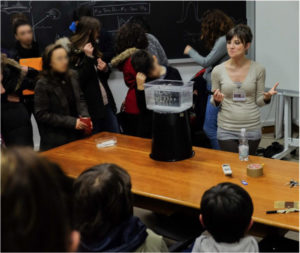 Sharing our knowledge with anyone who is not an expert is always so nice, especially when it comes to dealing with curious people and especially with kids, those who have thousands of interesting questions all the time.
Sharing our knowledge with anyone who is not an expert is always so nice, especially when it comes to dealing with curious people and especially with kids, those who have thousands of interesting questions all the time.
In 2016 the Rome Young Minds Section organized several interactive activities for the public during two events at the Department of Math and Physics of Roma Tre, namely “Eyes on the Moon” and “Eyes on Jupiter”. During these events there is a large public participation involving people of all ages, from kids to high school students to ordinary citizens (about 1400 particpants in total).
The topic of our activities is mainly focused on:
– water dealing with issues such as Archimedes’ principle, capillarity and the surface tension of liquids (hands-on labs).
– optics laws. The purpose of the activity was to provide an opportunity to discover optics (geometrical and physical) by means of hands-on labs.
– interactive exhibition about Jupiter and its moons. This activity was organized by means of printed images and interactive web sites, some of which created by us for this event (https://roma3astrogarden.wordpress.com/). The exhibition was animated for people browsing around, giving them the chance to discover Jupiter’s moons, its stunning auroras, the missions that are now studying the planet, and the large range of phenomena linked to it. This activity was run with the help of some third high school year students.
– the Earth and the Moon. We built a model of the Earth, the Moon and the Sun orbiting around each other (orrery) to show why the Moon is mischievous and always shows the same face. And what about the seasons? This orrery helped in getting the answers to these and many other curiosities, such as lunar phases and tides.
-the eye and the 3d vision. An experiment focused on eye’s functionality, divided into three steps: the anatomical components of a healthy eye, how these components work together, and why, if one eye works perfectly alone, we have two of them? In this regard, a demonstration on how our brains are able to make us understand the three-dimensions, using a stereoscope, was given. Moreover was explained the concept of the cinema 3D vision, with practical demonstration of the three-dimensional view of a siderite through anaglyph glasses.
